Introduction to Micro Economics Class 12 Economics
What is an Economy?
An economy is a system that includes the production, distribution, and consumption of goods and services within a particular region, such as a country. It involves various actors, including individuals, businesses, and the government, who interact within markets to allocate resources efficiently.
What is Economics?
Economics is the study of how people, businesses, and governments make choices about how to use limited resources. It explores how we decide what to produce, how to produce it, and who gets to use the things that are made.

A Simple Economy
- Needs are unlimited: In any society, individuals have a big list of goods and services they need for everyday life, such as food, clothing, shelter, transportation, and various other services.
- Resources are limited: Individuals and decision-making units, such as family farms, weavers, teachers, and labourers, use their resources to produce some goods and services and exchange them for the ones they need. For instance, a farmer can produce fruits and vegetables on his own farm and sell them in order to buy other things like clothes, shoes, etc. Similarly, a teacher may earn a salary in exchange for his teaching services at a school, and use that money to fulfil his daily needs. These resources are limited, for instance, a farmer can only grow a certain amount of fruits and vegetables and a teacher can only teach for a certain number of hours each day. Therefore, the money they will earn to buy other goods and services will also be limited.
- Needs exceed resources: Each individual has limited resources compared to their needs and wants, so they must make choices and choose certain goods and services over others. In other words, no individual can buy everything he wants.
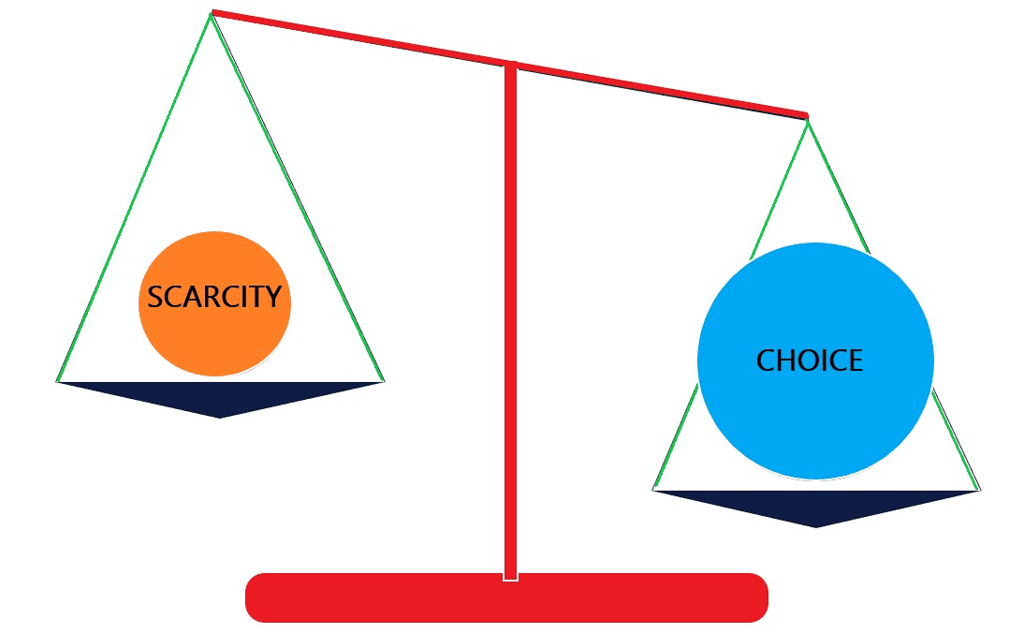
- There must be compatibility between what people collectively want and what is produced in society. When production does not match what people want, it can lead to overproduction (producing too much of something) or underproduction (producing too little of something). Both scenarios can create problems like wasted resources, shortages, or economic downturns.
- The resources of society are also scarce compared to what people collectively want, so proper allocation and distribution of goods and services are important.
- The allocation of limited resources and the distribution of the final mix of goods and services are fundamental economic problems faced by society.
Central Problems of an Economy
‘Economic problem’ is the problem of choice involving the satisfaction of unlimited wants out of limited resources having alternative uses.
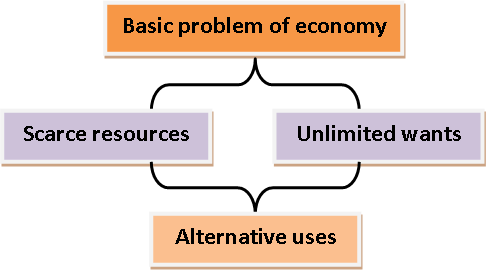
Scarcity: Resources like money, time, and materials are limited. This limitation is called scarcity. Because of scarcity, we can't have everything we want, so we have to make choices about how to use what we have.
Alternative uses: Each resource has multiple uses and society must decide about how to use the resource. For example, if a country has limited land, it has to choose whether to use it for farming, building houses, or making factories. Each choice comes with a trade-off because using the land for one thing means it can’t be used for something else.
Reasons for Economic Problem
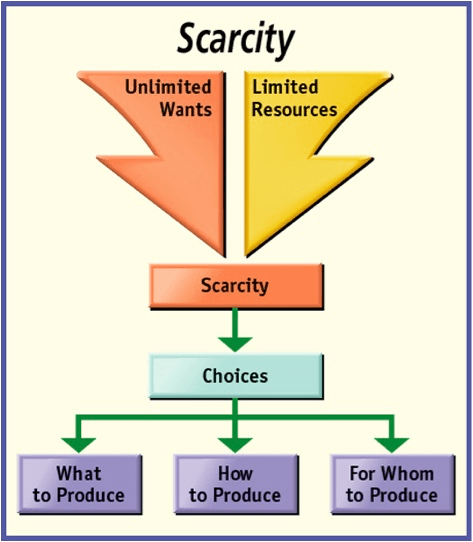
- Because of the scarcity of resources, the central problems of an economy arise.
- An economy, therefore, must make decisions about these three questions: what to produce, how to produce and for whom to produce.
The central problems faced by an economy can be categorized under three heads:

1. What is produced and in what quantities?
This problem involves the selection of goods and services to be produced and the quantity to be produced of each selected commodity. It arises since resources are limited in an economy and can be put to alternative uses.
The problem of 'What to produce' has two aspects:
- What possible commodities to produce: An economy has to decide, which consumer goods (rice, wheat, clothes, etc.) and which of the capital goods (machinery, equipment, etc.) are to be produced. In the same way, the economy has to choose between civil goods (bread, butter, etc.) and war goods (guns, tanks, etc.).
- How much to produce: After deciding the goods to be produced, the economy has to decide the quantity of each commodity that is selected. It means it involves a decision regarding the quantity to be produced, of consumer and capital goods, civil and war goods and so on. Guiding Principle: The guiding principle is to allocate resources in such a way that maximum individuals in the economy are satisfied.
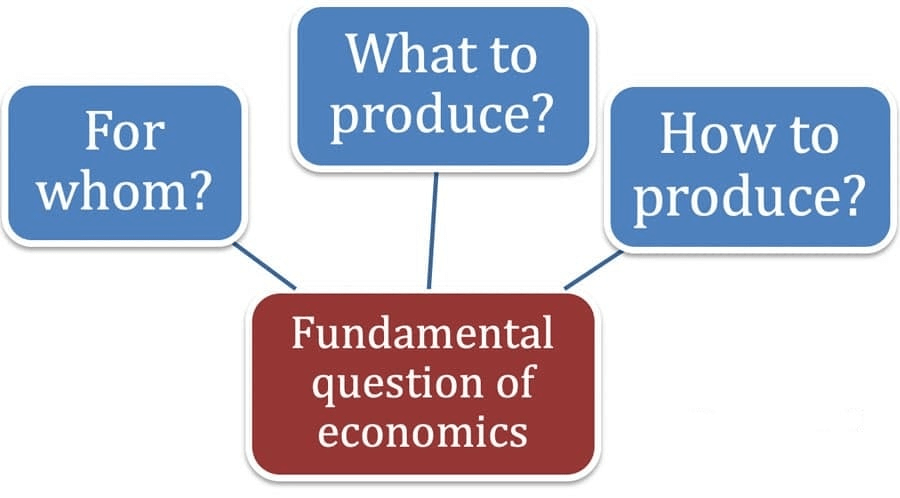
2. How are these goods produced?
This problem is concerned with the choice of technique of production to produce a given level of output.
For instance, a factory can choose between the following production techniques:
- The labour-intensive technique (where more labour is used than capital) or
- The capital-intensive technique (where more capital is used than labour) so that production is carried at minimum cost.

Example: Clothes can be produced with the help of handloom which ensures greater employment (labour-intensive technique) or with the help of modern power looms which ensure greater efficiency and productivity (capital-intensive techniques).
Sometimes, therefore, there can be a choice between choosing to employ more people and generating more income for society or choosing a capital-intensive method that is faster and more efficient.
3. For whom are these goods produced?
- This problem deals with the question of how an economy distributes its total production among different economic units (who gets how much to consume) and refers to the distribution of income and wealth in society.
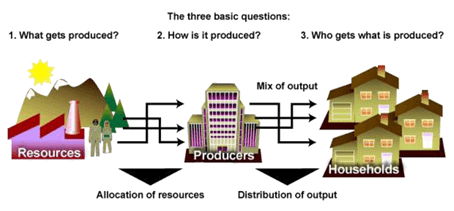
Example: How much a computer engineer consumes is based on his earnings as compared to a doctor or a teacher. It has two aspects:
(a) Personal Distribution among different individuals and households. It is concerned with the problem of inequality in distribution.
(b) Functional Distribution among different factors of production (land, labour, capital, entrepreneur). It is not related to the problem of inequality.
Production Possibility Frontier
- Production Possibility Frontier (PPF), also known as Production Possibility Curve (PPC) is a concave curve that shows all the possible combinations of the set of 2 goods produced in an economy.
- It tells about the combinations of goods and services that an economy can produce with the available limited resources and gives technology, assuming that the resources are utilized fully and efficiently.
Graphically:
Suppose an economy decides to produce only two goods corn (representing agricultural goods) and cotton (representing industrial good).
- If 10 units of cotton are grown, then there is no space for corn to grow. This possibility is shown by point A.
- If 9 units of cotton is grown, then 1 unit of corn can be grown which is represented by B.
- Similarly, the other combinations are represented by points C, D and E.
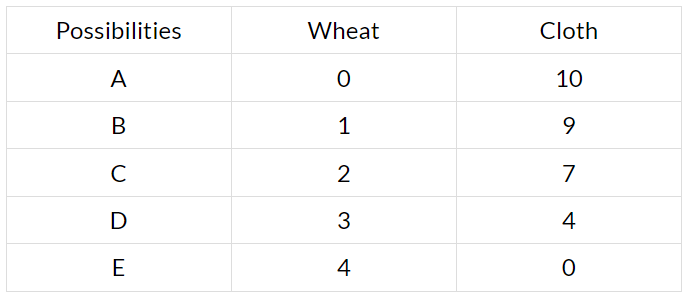
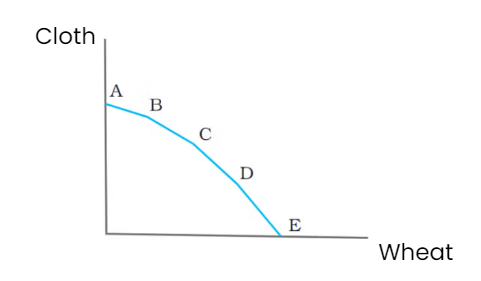
Opportunity Cost:
Opportunity cost is the value of the next best alternative that you give up when you make a decision.
- If we use more of our limited resources to produce more of wheat, there will be fewer resources left for making cloth, and the same goes the other way.
- So, if we want to increase the amount of wheat we produce, we'll end up producing less cloth, and if we focus more on making cloth, we'll have less wheat.
- Understanding opportunity cost helps you make better choices by thinking about what you miss out on when you pick one option over another.
Organization of Economic Activities
 |
Download the notes
Chapter Notes - Introduction to Microeconomics
|
Download as PDF |
The Centrally Planned Economy
- In a centrally planned economy, the government or central authority makes all important decisions regarding the production, exchange, and consumption of goods and services.
- The central authority aims to achieve the desired allocation of resources and distribution of goods and services for the benefit of society as a whole.
- If certain essential goods or services are lacking, the government may encourage individuals to produce them or produce them themselves.
- The central authority may also intervene to ensure a fair distribution of goods and services if some individuals are at risk of not receiving enough for their survival.

The Market Economy
- In a market economy, all economic activities are organized through the market.
- A market is an institution that allows individuals to freely exchange their goods and services.
- The term "market" in economics differs from its common understanding and can involve physical locations, telephone, and Internet interactions.
- Coordination in a market system is achieved through the price of goods and services.
- Prices send important information to individuals and help solve the central problems of production.
- All economies are mixed economies, with a combination of government decisions and market activities.
- The role of the government in the economy varies, with the US having minimal government involvement and China historically having a centrally planned economy.

Positive and Normative Economics
- There are multiple ways to solve the central problems of an economy.
- These different mechanisms result in different allocations of resources and distributions of goods and services.
- It is important to determine which mechanism is more desirable for the economy as a whole.
- Economics analyzes and evaluates these mechanisms and their outcomes.
- Positive economic analysis studies how the mechanisms function, while normative economics evaluates how they should function.
- The distinction between positive and normative analysis is not strict, as both are closely related and understanding one requires understanding the other.
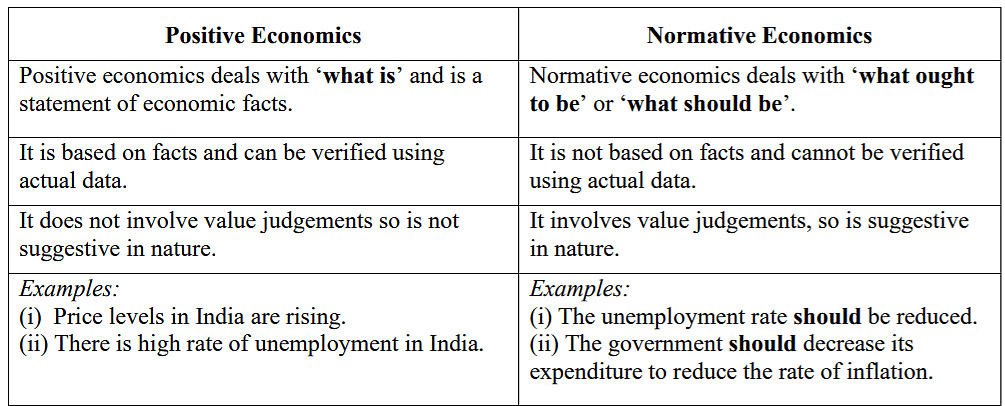 Positive Vs. Normative Economics
Positive Vs. Normative Economics
Microeconomics and Macroeconomics
- Economics is traditionally studied under two branches: Microeconomics and Macroeconomics.
- Microeconomics focuses on individual economic agents and their interactions in markets for goods and services.
- Macroeconomics looks at the economy as a whole, analyzing aggregate measures like total output, employment, and price level.
- Macroeconomics seeks to understand how these measures are determined and how they change over time.
- Questions in macroeconomics include determining total output, explaining its growth, and understanding resource unemployment and price increases.
- Unlike microeconomics, macroeconomics examines the behaviour of aggregate measures rather than individual markets.
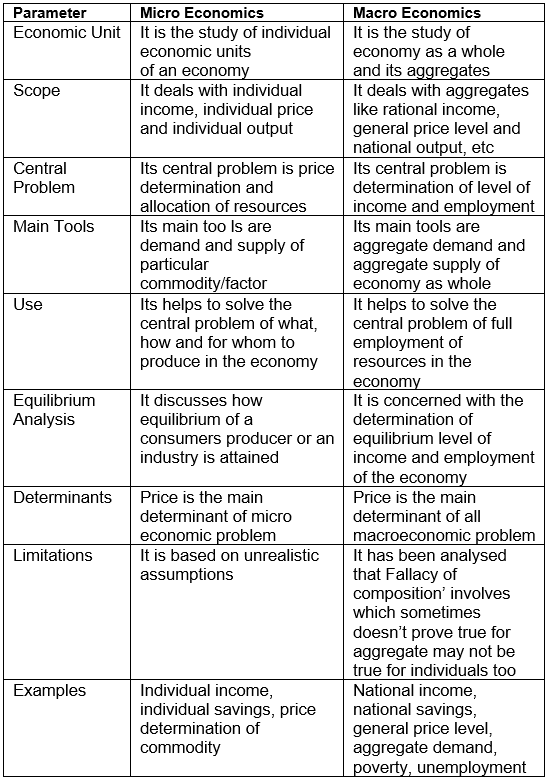 Difference between Micro and Macro Economics
Difference between Micro and Macro Economics
|
58 videos|216 docs|44 tests
|
FAQs on Introduction to Micro Economics Class 12 Economics
| 1. What are the central problems of an economy? |  |
| 2. What is the Production Possibility Frontier (PPF)? |  |
| 3. How are economic activities organized in a simple economy? |  |
| 4. What is the difference between positive and normative economics? |  |
| 5. What is the difference between microeconomics and macroeconomics? |  |
































